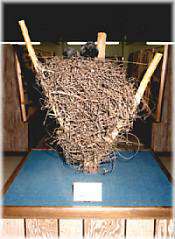

The internationally recognized museum displays over 700 varieties of barbed wire and related fencing items. Also housed in the museum is one of the largest collections of fencing tools in the world. Dioramas depict the use of barbed wire in the 19th century. A library and theatre provide visitors an opportunity to learn more about the settlement of the region.
One of the most unusual specimens in the museum's collection is an authentic Ravens' nest built  primarily of barbed wire. Discovered in a tree in Greeley County, Kansas in the 1960?s, this massive nest is a tribute to the ingenuity of these feathered creatures.
primarily of barbed wire. Discovered in a tree in Greeley County, Kansas in the 1960?s, this massive nest is a tribute to the ingenuity of these feathered creatures.
A display of military wire and wire tools illustrates the significant role of barbed wire in 20th Century warfare. Although barbed wire had been originally invented as a deterant to livestock, it was quickly modified for use against humans.
The Early Days: The Invention That Tamed the WestNames like Wyatt Earp, Bat Masterson, or "Wild" Bill Hickock instantly conjure up images of a wild West. Alongside these men, there is another name, perhaps not as familiar, but important just the same. So important, in fact, that without him, the wild West may never have been tamed. He was a banker, a businessman, and a farmer. He even served as the Sheriff of his community. However, is it for one of his first inventions that he is most well remembered. His name was Joseph Glidden and his invention changed the lifestyle of midwestern settlers.
In 1874, Joseph Glidden designed and patented a type of wire fencing known as barbed wire. In a short time, his invention flourished into a multi-million dollar industry. "Cheaper than dirt and stronger than steel," was the slogan shouted by promoters of this new style fencing. Great expanses of prairie were soon divided; cattle and Bison could no longer roam freely across the plains. A new way of life was born; the West was being tamed. This new way of life did not to come without a price. Battles were fought both in the courtroom and on the range. There were few winners, and a lot of losers. Some people even paid with their lives.
The Early 20th Century: Barbed Wire Goes to War:
Twists of steel with razor sharp points glistening in the sun communicate the message "you're not welcome here." Originally invented as a means of restraining animals, barbed wire was soon modified as a successful means of restraining humans. Rolls of twisted barbed wire, known as concertina wire, first came into wide spread use during the first World War. It has been used in every military conflict of the 20th century as an effective deterrant to foot soldiers and land vehicles. Rolls of concertina wire were stretched like a spring over miles of hillsides and ravines. Razor sharp points on the wire could inflict painful wounds upon those who tried to cross over, through, or under a fence. The high tensile strength and elasticity of twisted concertina wire would hopelessly entangle large vehicles and equipment. Barbed wire had become a weapon of war.